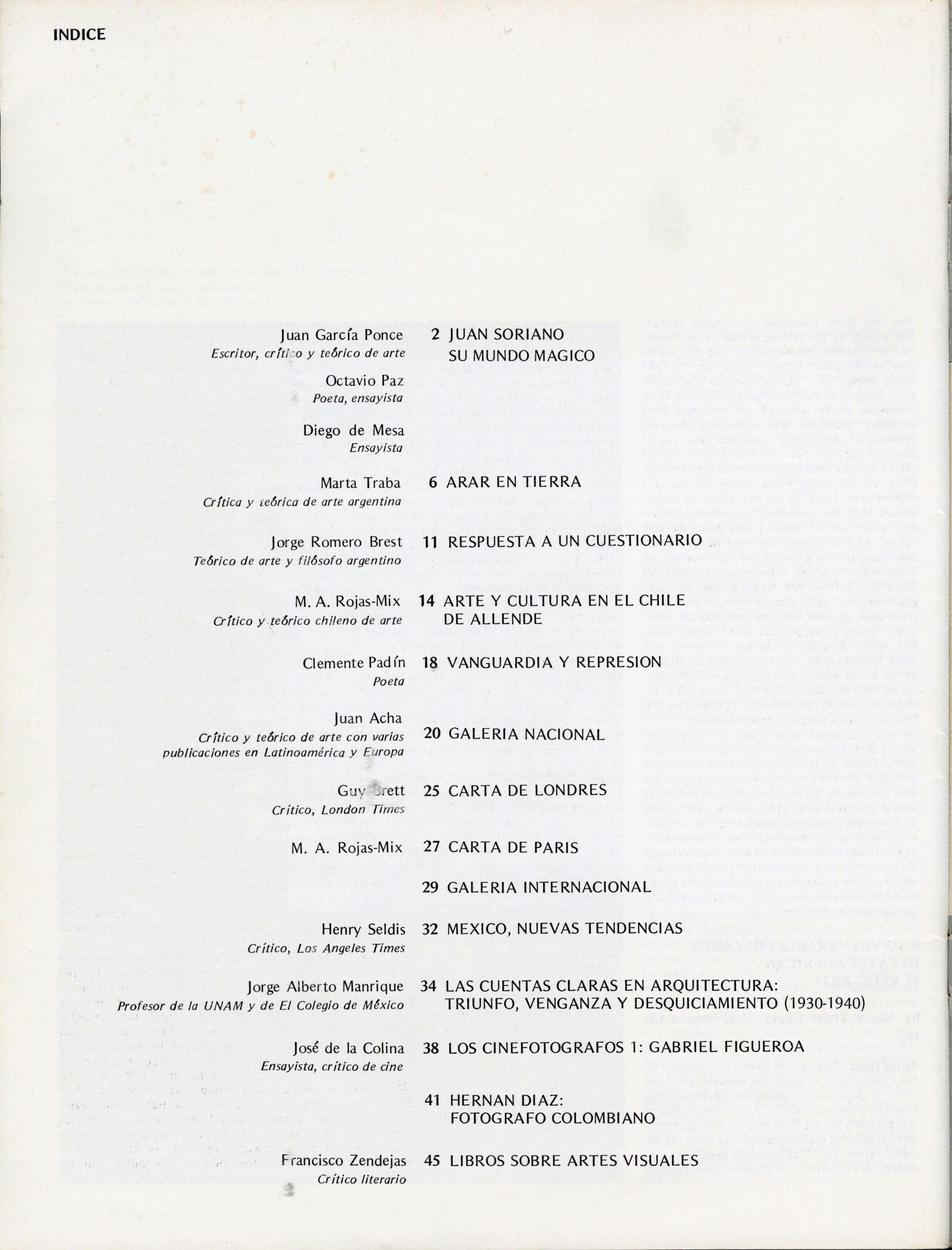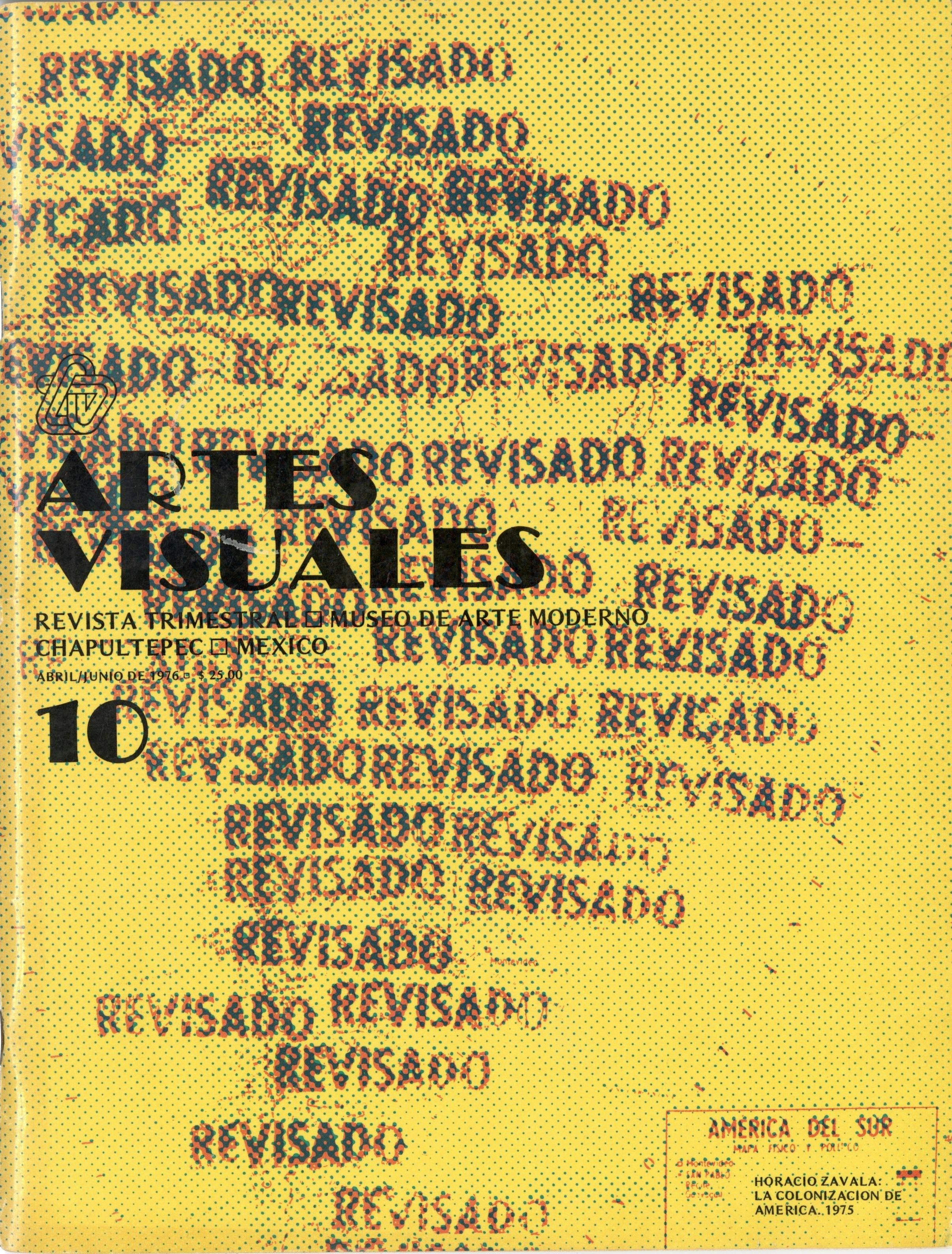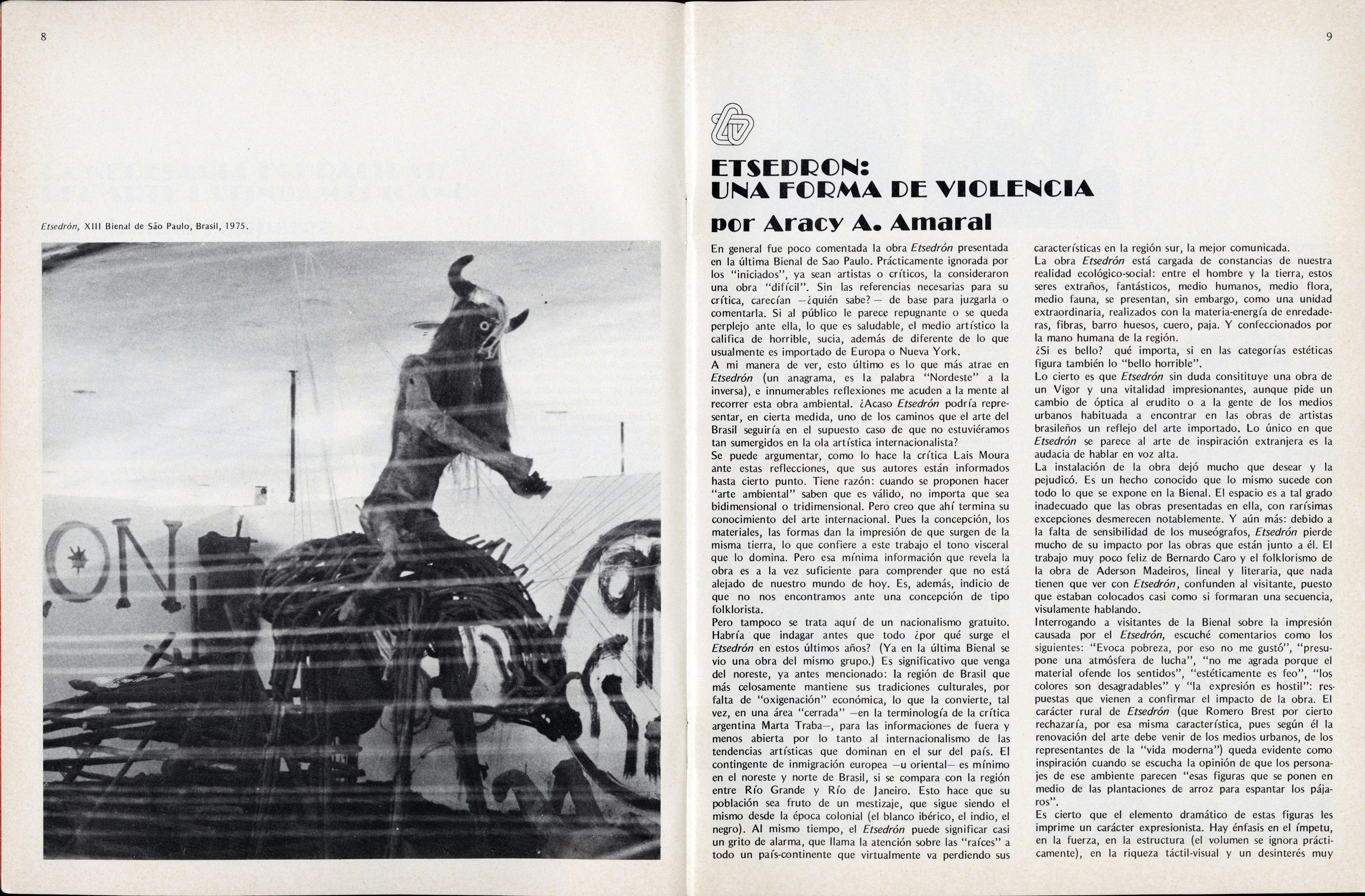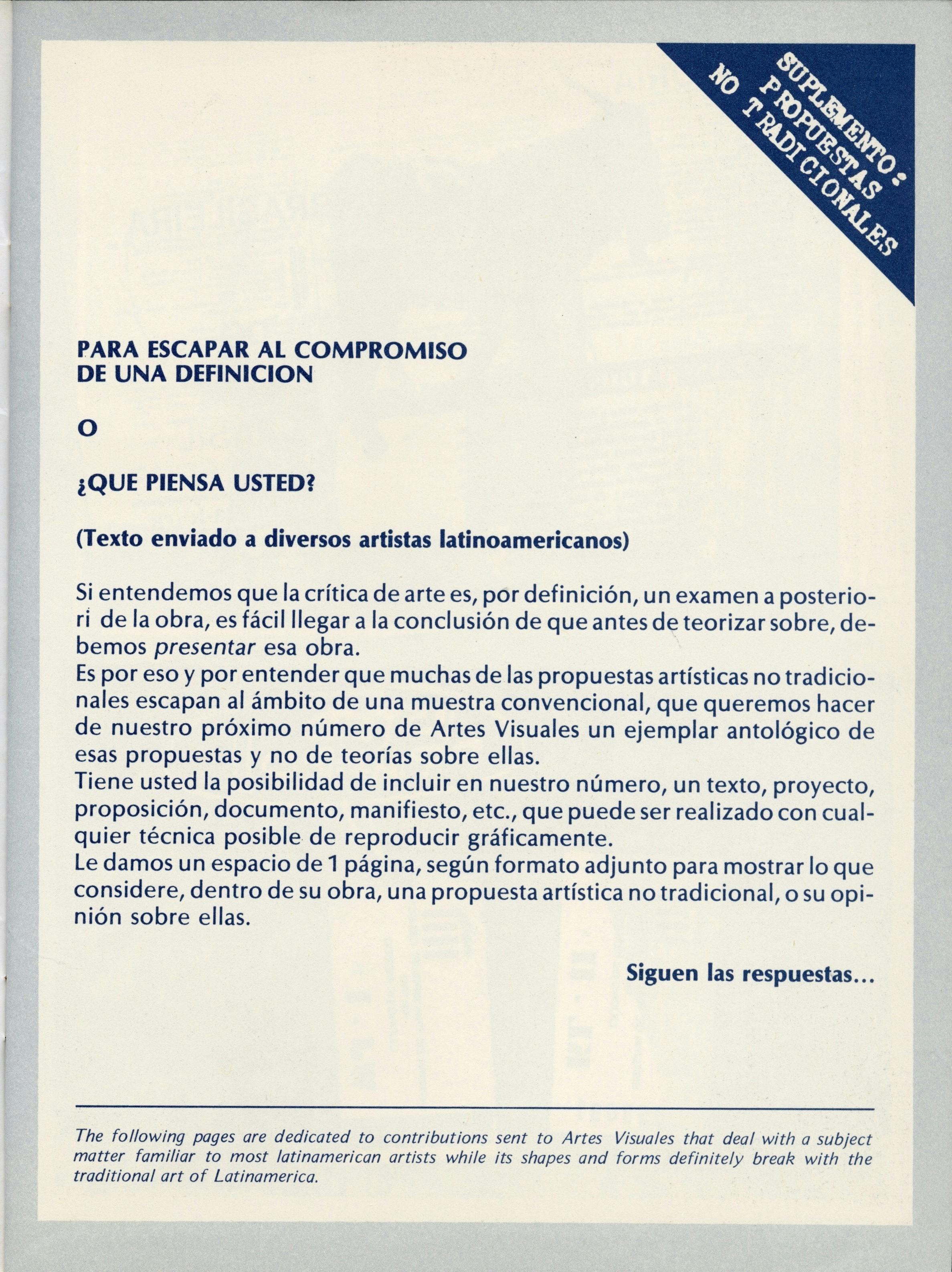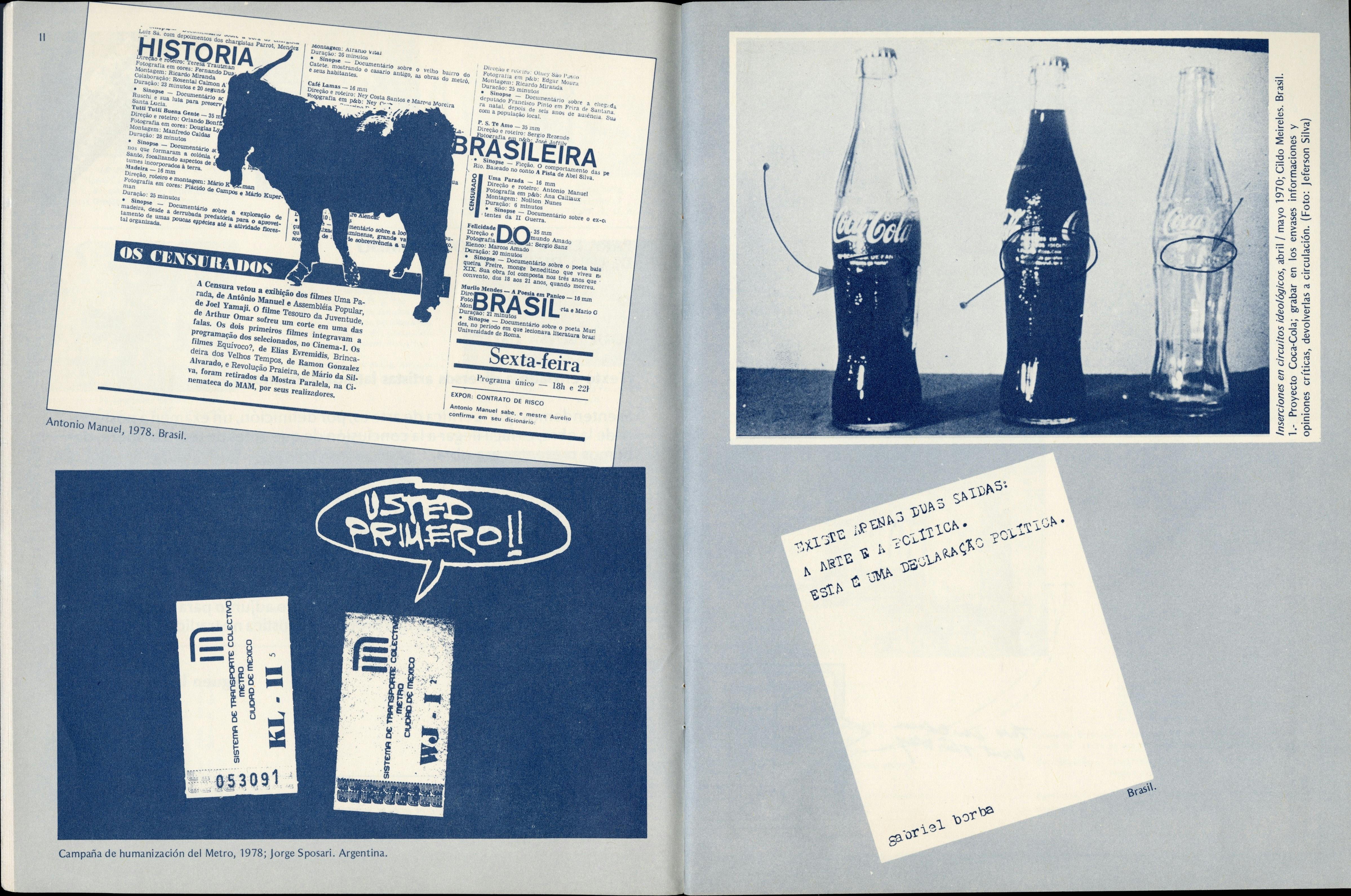Cover of the first issue of "Artes Visuales," Winter 1973. Institute for Studies on Latin American Art (ISLAA) Library and Archives
The Writer in Residence series offers scholars the opportunity to conduct research on Latin American art through materials in the ISLAA Library and Archives.
The first issue of Artes Visuales, a magazine published by the Museo de Arte Moderno in Mexico City under the direction of the writer and curator Carla Stellweg, came into existence the winter of 1973. 1 In September of the same year, Augusto Pinochet had commanded a coup against Salvador Allende in Chile, continuing a long cycle of military dictatorships throughout Latin America that began in Brazil in 1964. These dictatorships were characterized by an atmosphere of political exile, censorship, and brutal repression but also sparked intellectual conversations about the present and future of a united Latin American culture. The dictatorships were also a reaction to the strong influence of the radical leftist ideology of the Cuban Revolution (1959) on North American imperialism, which triggered postcolonial and anticapitalist struggles, guerrillas, attempts at revolution, and political upheaval in the entire area.
Written during this volatile time, the first editorial statement of Artes Visuales posited that “countries with many common problems, such as those of Latin America, need to dialogue and jointly confront the questions of their artistic sensibility.” 2 The magazine became a sort of think tank for the search for a Latin American identity through modern and contemporary art as well as for pioneering subjects such as feminism, performance art, and conceptual art. Artes Visuales gathered collaborations and debates between the most important art critics, academics, theorists, and curators in the region at that time: Marta Traba, Jorge Romero Brest, Damián Bayón, and Néstor García Canclini, from Argentina; Juan Acha, from Peru; Mário Pedrosa and Aracy Amaral, from Brazil; and Rita Eder and Carla Stellweg, from Mexico, among others.
The magazine became a sort of think tank for the search for a Latin American identity through modern and contemporary art as well as for pioneering subjects such as feminism, performance art, and conceptual art.
The heavy theoretical discussions that were published in Artes Visuales covered a wide range of artists and artworks in Latin America, such as the classic Mexican modernist paintings of Rufino Tamayo and Diego Rivera; the geometric Mexican art of Ángela Gurría, Manuel Felguérez, Gunter Gerzso, and Mathias Goeritz; the art of Latin Americans exiled in New York, such as Marta Minujín and Luis Camnitzer; the conceptual art practices of Víctor Grippo, Jorge Glusberg, and Horacio Zabala, who worked with the Centro de Arte y Comunicación (CAYC), founded in Argentina in 1968; and many other important artists from countries all over Latin America.
True to its title, the magazine honored the term "visual arts" by expanding its concept of art production to include film, video, performance art, architecture, and design—an expression of its avant garde intentions within the Latin American landscape. Throughout the magazine’s corpus, with some exceptions, its structure consisted of monographic texts about major artists from Mexico or other Latin American countries; theory-laden articles in which authors, addressing each issue’s topic, discussed the existence of a “Latin American art” within media such as video art, performance art, sculpture, visual poetry, and cinema, or in subjects such as feminism or Chicano art; a supplement that included writings on international theory and longer theoretical essays; and the columns “Galería Nacional” and “Galería Internacional,” dedicated, respectively, to national and international contemporary art news, accompanied by mixed media images and exhibition reviews.
The first issue of Artes Visuales includes an article by the Peruvian art critic Juan Acha titled “Toward a New Artistic Problematic in Latin American Art.” In it, Acha advocates for a search for vernacular and authentic “Latin American features,” in opposition to what he calls a “developmentalist aesthetic,” 3 imported from “rich” foreign countries, particularly the United States. In Acha’s view, Latin America needed to end its epigonic relationship with the West by embracing the creation of a new political and social context suggested by an aesthetic revolution. Acha identifies two fundamental historical tendencies in the art of the region: the intellectualist and the psychological. The first tendency comes from the model of the developmentalist aesthetic, imported from industrial societies to “underdeveloped” ones, which creates a gap between the two and has nothing to do with life in Latin America. On the other hand, the psychological tendency advocates for popular culture, spontaneous expression, and the excessive use of nationalism and folklore. Employed separately, the two tendencies are, in Acha’s view, detrimental to the art of the region, weakening it. Together, however, they can build a path toward a solid exploration of Latin American art.
In his influential text, Acha formulated a question that would later become central to the magazine, which published thoughtful debates around it in several of its issues: Is there a Latin American art? The entire continent was pondering that question. 4 In 1971, the Cuban intellectual Roberto Fernández Retamar began his famous anticolonial essay, “Calibán,” published in the Havana-based magazine Casa de las Américas, with these words:
"A European journalist, and moreover a leftist, asked me a few days ago, “Does a Latin American culture exist?” . . . The question seemed to me to reveal one of the roots of the polemic and, hence, could also be expressed another way: “Do you exist?” For to question our culture is to question our very existence, our human reality itself." 5
Published in the summer of 1974, the third issue of Artes Visuales is dedicated to answering this question, with articles by Marta Traba, Jorge Romero Brest, the Chilean writer and historian Miguel Rojas-Mix, the Uruguayan poet and artist Clemente Padín, and the English art critic and curator Guy Brett.
Marta Traba argued that Latin American art is shaped by American colonization and imperialism.
Traba argued that Latin American art is shaped by American colonization and imperialism. In her 1974 essay “Arar en tierra,” (Plowing on Land) she classifies two types of relationships between the two regions: the aesthetics of resistance, which emerge as an attempt to decolonize the experience of art, and the submission to “American civilization.” 6 For Traba, affirming Latin Americanism requires a separation from the US and its influence. Traba harshly criticizes the decadence of the art produced within the “empire”: “Thus, to the unmitigated stupidity of socialist realism is added the unmitigated stupidity of capitalist realism,” 7 she writes of the new American trend of hyperrealist painting led by artists such as Chuck Close and Richard Estes. The Argentine critic goes on to assert that, in this context, the only options for Latin American artists are “copying fast” and “thinking slow.” Traba maintained that the original motivations behind the São Paulo Biennale were to create a copy of the Venice Biennale model. She criticized the pan-Americanism of the 1950s and the work that Cuban diplomat and curator José Goméz Sicre made for the Organization of the American States in order to disseminate modernist architecture and painting throughout Latin America as part of the American way of life, which Traba saw as an attempt at neocolonial expansion in the area.
In Traba’s critical Marxist view, revolutionary Cuba was not the result of a successful cultural autonomous process either, because even when the Revolution provided “some optimism” to the area, it did so while surrendering to Soviet imperialism. Traba’s pessimism was aggravated by the coup against Allende, which stymied his government’s important support for change to the political and cultural landscape in Latin America. Traba’s proposed solution to these problems consisted of “driving visual art . . . through a permanent state of insurgency.” 8 Her article reveals a tension between the magazine’s philosophy and the institution that made it possible, which was inspired by the American model of the modern museum. In contrast to Traba’s statements, the images that illustrate the texts show works by the Colombian modern sculptor Edgar Negret (Assemblage no. 5, 1971), an untitled painting by the Peruvian artist Fernando de Szyszlo, a painting installation by the Guatemalan artist Luis Díaz with abstract patterns that described the flight of the Quetzal bird (El Quetzal en persona, representación de su vuelo, 1972), and an ironic happening by the Argentine performer Lea Lublin (Inflatables to Entertain the Bourgeois, from the 1970s.)
Traba’s idea of an art practice in “permanent insurgency” seems to be in line with the muralist movement that emerged from the period of Allende’s short-lived government, described in Rojas-Mix’s article in the same issue. The so-called “arte brigadista” (brigade art) was created by popular art collectives that generated an agitprop kind of art, in service to the construction of the socialist revolution started by Allende. Inspired by the Mexican muralist tradition of of the 1920s and 30s, in Chile, as Rojas-Mix explains in his article, murals were a way to fight back against the mass media controlled by the political right and to expand messages of international, intersectional solidarity, such as the campaign to free the American anti-racist activist Angela Davis from prison in the early 1970s. This idea of using art as a tool to bring to light social struggles or social disciplines featured prominently in Artes Visuales, even on the infrequent occasions when the magazine had to show its commitment to the modern formalist values championed by the Museo de Arte Moderno. In the fourteenth issue of the magazine, the Cuban art critic Adelaida de Juan writes about a political propaganda poster produced during the Cuban Revolution of the 1970s, showing posters by Raúl Martínez and Luis Martínez Pedro, two Cuban abstract painters active in the 1950s who shifted their aesthetics toward a mass media style of design, such as Pop art, in order to support the government. In the same issue, the Argentine theorist Néstor García Canclini explores the social dimension of the work of Mexican photographers Manuel Álvarez Bravo and Lázaro Blanco.
Years prior, Clemente Padín presented a text in the third issue of Artes Visuales titled “Vanguardia y represión” (Vanguard and Repression), where he introduces the work of the CAYC through a story of censorship. Padín describes how the Argentine government censored the famous outdoor exhibition Arte e ideología: CAYC al aire libre (Art and Ideology: CAYC in the Open Air), at Plaza Roberto Arlt in Buenos Aires in 1972, arguing that the show did not conform to what the authorities had defined as art. The outdoor exhibition was an attempt to bring art to the streets, opposing elitist museum and gallery culture and the capitalist art system by displaying experimental works with strong political messages in the street alongside “pedestrians, couples making love, groups of students, and children playing in the square.” 9 Challenging the established art spaces thereby allowed art to reach a massive public audience, which aligned with the idea of a social revolution that occurred either through exposure to revolutionary propaganda (such as posters and murals) in Cuba and Chile or through collective initiatives like CAYC, where “communication” theories were fundamental in changing the social and political landscape of Latin America through the creation of a new audience.
In Mexico, the anthropologist, architect, and museum director Iker Larrauri, who led the museums of the Instituto Nacional de Antropología e Historia in Mexico until 1976, addressed this subject that same year, stating that these institutions were an instrument of the dominant class and that “the[ir] elitist character is manifested in their inability to respond adequately to the social interests of those they are intended to serve.” 10 As if to exonerate itself from the guilt of being published by an elitist museum, since its creation in 1973, Artes Visuales launched itself to become a platform for alternative art production beyond established art spaces in Latin America. The magazine dedicated several issues to the impact of mass media on contemporary art, featuring texts by Marshall McLuhan in issue seven and entire dossiers on video art in issue seventeen. The magazine often showcased artworks made for printed formats, advocating for an understanding of “art publications from sculptural institutions” through collaborations from artists Luis Camnitzer, Isabel de Obaldía, Vito Acconci, Horacio Zabala, and Leopoldo Maler as a response to an open call to address the reincorporation of the Panama Canal to Panama in 1979 (issue twenty), after the Torrijos-Carter Treaties in 1977.
Much like the classic conceptualist art of the 1960s and 70s in the US, the Latin American vanguard ascribed to the idea that “the medium is the message.” In an article dedicated to the future of art criticism in Latin America, Néstor García Canclini declared that “finally, sociological and communication studies show that art is not just a collection of works but a process of production, distribution, and consumption of goods governed by laws to some extent similar to those that control the circulation of everything else.” 11 Canclini thus aligned himself with an artistic paradigm established by Marcel Duchamp in 1917 withFountain, through which the French artist proposed that the institutional context is what defines the artwork. Years later, in 1981, when Artes Visuales ceased publication, Juan Acha presented the first Latin American Conference on Non-Objectualist Art at the Museo de Arte Moderno de Medellín, Colombia, a theoretical attempt to address the aesthetics of dematerialization in Latin America.
Following the ideas outlined in Traba’s radical 1974 article, mentioned earlier, conceptual art in Latin America can be understood as a reflection of the conceptualist movement in the US at that time. Traba believed that, in the Global North, art was a function of the development of technology and commodities within the assembly line of Capital. For this reason, she described the Western media’s artistic experiments of that time as the “aesthetics of deterioration,” 12 in opposition to her proposal for an “aesthetics of resistance in Latin America.” However, in Latin America this regional mix of art and media—whose ultimate consequence is the mixing of art and life—was not being absorbed by capitalism, unlike in the US, as Hal Foster points out in The Return of the Real. 13 In Latin America, the reality of a dangerous vanguard directly correlated with the ferocity of the dictatorships of the 1970s and the violent political struggles that came with them. For Traba, artists thus became revolutionaries—activists who risked their own bodies and freedom for the mere act of practicing art. As an example, the eighteenth issue of Artes Visuales (published in 1978) includes, alongside printed artworks, a caption that condemned the political kidnapping in Uruguay of Clemente Padín, the same artist and poet who wrote about “vanguard and repression” in relation to CAYC in the third issue of the magazine, only four years prior.
One of the most pressing concerns of the magazine’s Latin American theorists was the integration of high art, embodied by Western culture, and popular tradition, represented by Indigenous crafts and the vernacular cultural practices of Black communities in Latin America.
One of the most pressing concerns of the magazine’s Latin American theorists was the integration of high art, embodied by Western culture, and popular tradition, represented by Indigenous crafts and the vernacular cultural practices of Black communities in Latin America. This tension between rationality (the conquest of nature) and “magic” is at the core of one the most important cultural themes of Latin American artistic production in the twentieth century. This phenomenon has been referred to as “the marvelous real” by the Cuban-French novelist Alejo Carpentier in 1949, “magic realism” by the Guatemalan writer Miguel Ángel Asturias, 14 and “Latin American Surrealism” by art historians of the 1920s, 30s, and 40s. The term “Latin American” denotes the propensity of reality itself to transcend rationality, creating a living surrealist experience as opposed to the dreams depicted on canvas by its European counterparts. The fourth issue of Artes Visuales explores the idea of Latin American Surrealism as the continent’s first real modern movement, alluding to its capacity to integrate the challenging plural identity and temporal diffractions of the region. In that issue, Mexican art critic Teresa del Conde discusses André Breton’s colonialist statement that Frida Kahlo had arrived at Surrealism unaware of what was being done in Europe. While del Conde embraces the idea of Mexico as a “surrealist country” in connection with its lived reality, she also emphasizes Kahlo’s connection with the international vanguard. In another text, writer Mariana Frenk finds parallels and coincidences between the Indigenous Mexican craft tradition and Surrealism, describing the serpent-headed Aztec goddess Coatlicue, for example, as an ancient version of Lautréamont’s vision of the marriage between a sewing machine and an umbrella. Meanwhile, in an article titled “Fantastic America” the art critic Marc Bouyer comments on how the medieval European tradition of the bestiary and its representation of the exotic as sinful has shaped the perception of Latin America since it was first colonized in 1492.
However, while Surrealism was taken as a historical point of reference and surrealist impulses persisted within the region’s artistic production, it was far from being a movement that could be integrated into contemporary art in the era of Artes Visuales (the 1970s.) In the summer of 1976, the magazine approached once again the challenging topic of the existence of an authentic integral Latin American art with a debate held between Aracy Amaral, director of the São Paulo Biennial from 1975 to 1979, and Juan Acha. The discussions revolved around a large installation presented at the thirteenth São Paulo Biennial, in 1975, titled Etsedrón (an anagram of the word Nordeste, meaning “northeast”), by the Brazilian art collective of the same name, whose members were interdisciplinary students of the School of Fine Arts of the Universidade Federal da Bahia, in Salvador, a place “where the European immigration did not go, a mestizo (mixed race) land.” 15
Etsedrón’s installation consisted of hybrid anthropomorphic figures with beast heads made of leather, vines, gourds, clay, seeds, and roots collected from Bahia, pointing to the group’s affiliation with poverty and the esoteric cultural practices of the region. While Etsedrón was underrated by the critics and rejected by the public, Amaral saw the installation as a possible alternative to the markedly “internationalist” aesthetics represented by classic Brazilian Concretism. Etsedrón exposed the flip side of liberal capitalism: the poverty of rural life, far from the splendor of cities. Amaral’s text is also part of a larger theoretical conversation and ongoing debate about Latin American art. Employing Traba’s terminology, Amaral described Etsedrón as driven by the intensity of an “enclosed” area, bringing the ecological energy of the earth to their art, in opposition to the ideals of Argentine art critic Romero Brest, who saw vanguards as an exclusive product of dense modern urbanization. The Brazilian curator also mentions the racial component of the artwork and its potential to define a future for Latin American culture, declaring that Etsedrón is “not ‘white,’” is imbued with a “mulatto personality,” and constitutes a strong response to elitist European definitions of Arte Povera and “primitivism,” used in the modern Western tradition to consume the culture of the other and treat it as a footnote, as seen in Les Demoiselles d’Avignon (1907), in which Pablo Picasso instrumentalized vernacular African masks. Amaral concludes: “In order for us to appreciate without prejudice a work such as Etsedrón, testimony of a mulatto artform, that appears before us in a Biennial whose model is Venice—what a scandal!—perhaps it would be useful to adopt (as suggested by the Peruvian critic Juan Acha), a critical Latin American approach rather than a critical European-American lens.” 16
In turn, Juan Acha sees Etsedrón’s work as different from what he referred to in his pioneering article from the first issue of Artes Visualesas “developmentalist aesthetics”—the international technological style produced by the experience of living in big cities. However, Acha is skeptical of the idea that this is the path that art should take in Latin America, recognizing that its international plurality poses a challenge to finding a paradigm for the whole region. In the same issue of the magazine, the art critic Damián Bayón, who studied under Romero Brest, rejects folklore and localism, arguing that “Latin American art must lose itself in the influence of other cultures and that the true provincialism according to Eco is to ‘always elaborate the neurotic sensation of being independent.’” 17
The conversations and debates in Artes Visuales were also taken to the São Paulo Biennial in the 1970s.
By publishing critical essays on identity, materiality and discourse from some of the foremost thinkers and artists throughout Latin America, Artes Visuales became a platform for the exchange of ideas in the sphere of Latin American art, the extent of which is readily evident when reviewing its pages, including those issues not analyzed in this essay. These conversations and debates were also taken to the São Paulo Biennial in the 1970s. The Mexican curator and scholar Rita Eder describes“ 18 how this process was made possible through only one edition of the Latin American São Paulo Biennial—a continental version of the global Biennale—in 1978, after Acha convinced Amaral to host the event, which ended with great controversy when the event’s award was given to Argentinian conceptual collective Grupo de los Trece (members of CAyC) and not to Etsedrón.
In the twentieth issue of the magazine, in the winter of 1979, Carla Stellweg wrote an editorial statement in which she rejected the idea of continuing to push for a Latin American problematic in art, arguing that this debate had become trendy and exclusionary of the ethnic diversity of the continent, as it frequently left out non-Spanish speakers from both the Caribbean islands and the continental area, failing to represent the vast array of native languages spoken throughout the region. For Stellweg, the “Latin Americanist approach of Artes Visuales was born out of the need to overcome the phenomenon of isolation,” but the magazine needed a “change of skin.” 19 The Mexican curator suggested that this “change of skin” was perhaps motivated by the recent interest in Latin American culture in the US. The irony in this sentence brings to mind the image of an ouroboros—a snake eating its own tail. What started as an attempt to define Latin American art by strongly opposing US neo-colonization might have resulted in acknowledging North American imperialism in order to update its colonial methods. 20


